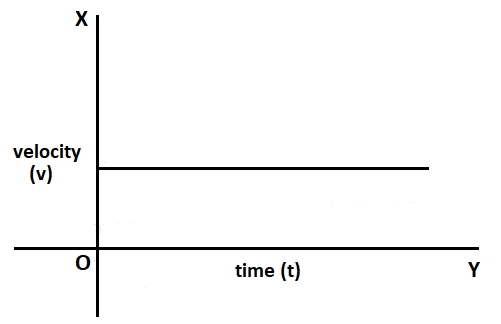
For a uniform motion,
A. the velocity – time graph is a straight line parallel to the time axis.
B. the position – time graph is a parabola.
C. The acceleration – time graph is a straight line inclined with time axis.
D. none of the above.
Answer
589.5k+ views
Hint: Objects in uniform motion travel equal displacements in equal time intervals. Objects in uniform motion do not speed up, slow down, or change direction. Now find out the graph which represents such a type of motion.
Complete step by step answer:
As we know that if a body covers equal distances in equal time intervals then it is said to move with uniform velocity and its motion is called uniform motion.
The velocity versus time (v – t) graph for a body moving with uniform speed is given as,

This graph represents that the body is in uniform motion because the velocity of the body remains constant and the body is covering equal distance in equal time interval of time.
This velocity vs. time (v – t) graph is a straight line parallel to the time (t) axis.
Hence, the correct option is A, i.e., the velocity – time graph is a straight line parallel to time axis.
Additional Information:
For representing uniform motion, if we plot a displacement (d) vs. time (t) graph then it will be a straight line inclined with time axis, which represents that the object covers equal distances in equal intervals of time.
Note: Students should understand the uniform motion and thereafter they need to know how to plot displacement vs. time graph and velocity vs. time graphs for representing the uniform motion. If the position vs. time graph is a parabola then it will represent non-uniform motion, so option B is incorrect and if the acceleration vs. time graph is a straight line inclined with time axis then it will represent increasing acceleration which is also a non-uniform motion, so option C is incorrect.
Complete step by step answer:
As we know that if a body covers equal distances in equal time intervals then it is said to move with uniform velocity and its motion is called uniform motion.
The velocity versus time (v – t) graph for a body moving with uniform speed is given as,

This graph represents that the body is in uniform motion because the velocity of the body remains constant and the body is covering equal distance in equal time interval of time.
This velocity vs. time (v – t) graph is a straight line parallel to the time (t) axis.
Hence, the correct option is A, i.e., the velocity – time graph is a straight line parallel to time axis.
Additional Information:
For representing uniform motion, if we plot a displacement (d) vs. time (t) graph then it will be a straight line inclined with time axis, which represents that the object covers equal distances in equal intervals of time.
Note: Students should understand the uniform motion and thereafter they need to know how to plot displacement vs. time graph and velocity vs. time graphs for representing the uniform motion. If the position vs. time graph is a parabola then it will represent non-uniform motion, so option B is incorrect and if the acceleration vs. time graph is a straight line inclined with time axis then it will represent increasing acceleration which is also a non-uniform motion, so option C is incorrect.
Recently Updated Pages
Why are manures considered better than fertilizers class 11 biology CBSE

Find the coordinates of the midpoint of the line segment class 11 maths CBSE

Distinguish between static friction limiting friction class 11 physics CBSE

The Chairman of the constituent Assembly was A Jawaharlal class 11 social science CBSE

The first National Commission on Labour NCL submitted class 11 social science CBSE

Number of all subshell of n + l 7 is A 4 B 5 C 6 D class 11 chemistry CBSE

Trending doubts
What is meant by exothermic and endothermic reactions class 11 chemistry CBSE

10 examples of friction in our daily life

One Metric ton is equal to kg A 10000 B 1000 C 100 class 11 physics CBSE

1 Quintal is equal to a 110 kg b 10 kg c 100kg d 1000 class 11 physics CBSE

Difference Between Prokaryotic Cells and Eukaryotic Cells

What are Quantum numbers Explain the quantum number class 11 chemistry CBSE




